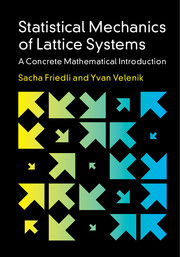Book contents
- Frontmatter
- Dedication
- Contents
- Preface
- Conventions
- 1 Introduction
- 2 The Curie–Weiss Model
- 3 The Ising Model
- 4 Liquid–Vapor Equilibrium
- 5 Cluster Expansion
- 6 Infinite-Volume Gibbs Measures
- 7 Pirogov–Sinai Theory
- 8 The Gaussian Free Field on Zd
- 9 Models with Continuous Symmetry
- 10 Reflection Positivity
- Appendix A Notes
- B Mathematical Appendices
- C Solutions to Exercises
- References
- Index
5 - Cluster Expansion
Published online by Cambridge University Press: 17 November 2017
- Frontmatter
- Dedication
- Contents
- Preface
- Conventions
- 1 Introduction
- 2 The Curie–Weiss Model
- 3 The Ising Model
- 4 Liquid–Vapor Equilibrium
- 5 Cluster Expansion
- 6 Infinite-Volume Gibbs Measures
- 7 Pirogov–Sinai Theory
- 8 The Gaussian Free Field on Zd
- 9 Models with Continuous Symmetry
- 10 Reflection Positivity
- Appendix A Notes
- B Mathematical Appendices
- C Solutions to Exercises
- References
- Index
Summary
Introduction
The cluster expansion is a powerful tool in the rigorous study of statistical mechanics. It was introduced by Mayer during the early stages of the study of the phenomenon of condensation and remains widely used nowadays. In particular, it remains at the core of the implementation of many renormalization arguments in mathematical physics, yielding rigorous results that no other methods have yet been able to provide.
Simply stated, the cluster expansion provides a method for studying the logarithm of a partition function. We will use it in various situations, for instance to obtain new analyticity results for the Isingmodel in the thermodynamic limit.
In a first application, we will obtain new results on the pressure, completing those of Chapter 3. There, we saw that the pressure is analytic in the half-space, but the techniqueswe used did not provide further quantitative information. Here wewill use the cluster expansion to compute the coefficients of the expansion of, in terms of the variable:
In our second application, wewill fix h = 0, and study the analyticity of. We will obtain, when is sufficiently small, an expansion in terms of the variable,
One might hope that this series converges for all. Unfortunately, the method developed in this chapter will guarantee analyticity only when, where is some number, strictly smaller than the critical value. We will call a regime such as a regime of very high temperature to distinguish it from the high-temperature regime used in earlier chapters.
Similarly, we will also obtain, when is sufficiently large, an expansion in terms of the variable,
Once again, this series will be guaranteed to converge at very low temperature, that is, for all, where.
Of course, the cluster expansion is not limited to the study of the pressure in these different regimes and we will show how it can be used to extract additional information on other quantities of interest. In particular, at very low temperatures, we will derive a series expansion for the spontaneous magnetization and prove exponential decay of the truncated 2-point function.
We hope that this sample of applications will convince the reader that the cluster expansion is a versatile tool that, even though applicable only in restricted regions of the space of parameters, provides precious information often unavailable when using other techniques.
- Type
- Chapter
- Information
- Statistical Mechanics of Lattice SystemsA Concrete Mathematical Introduction, pp. 232 - 261Publisher: Cambridge University PressPrint publication year: 2017

